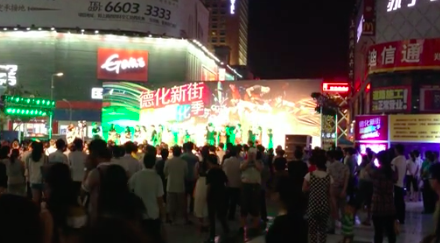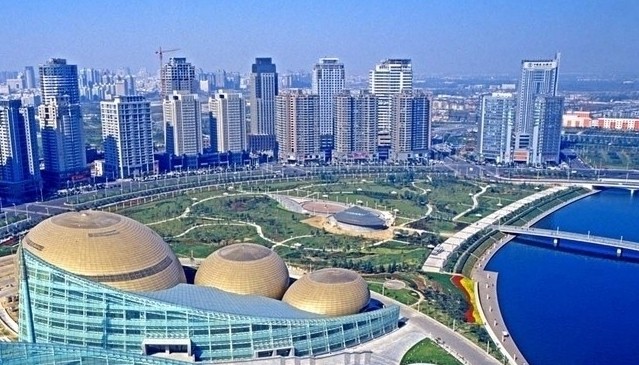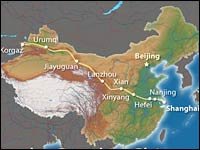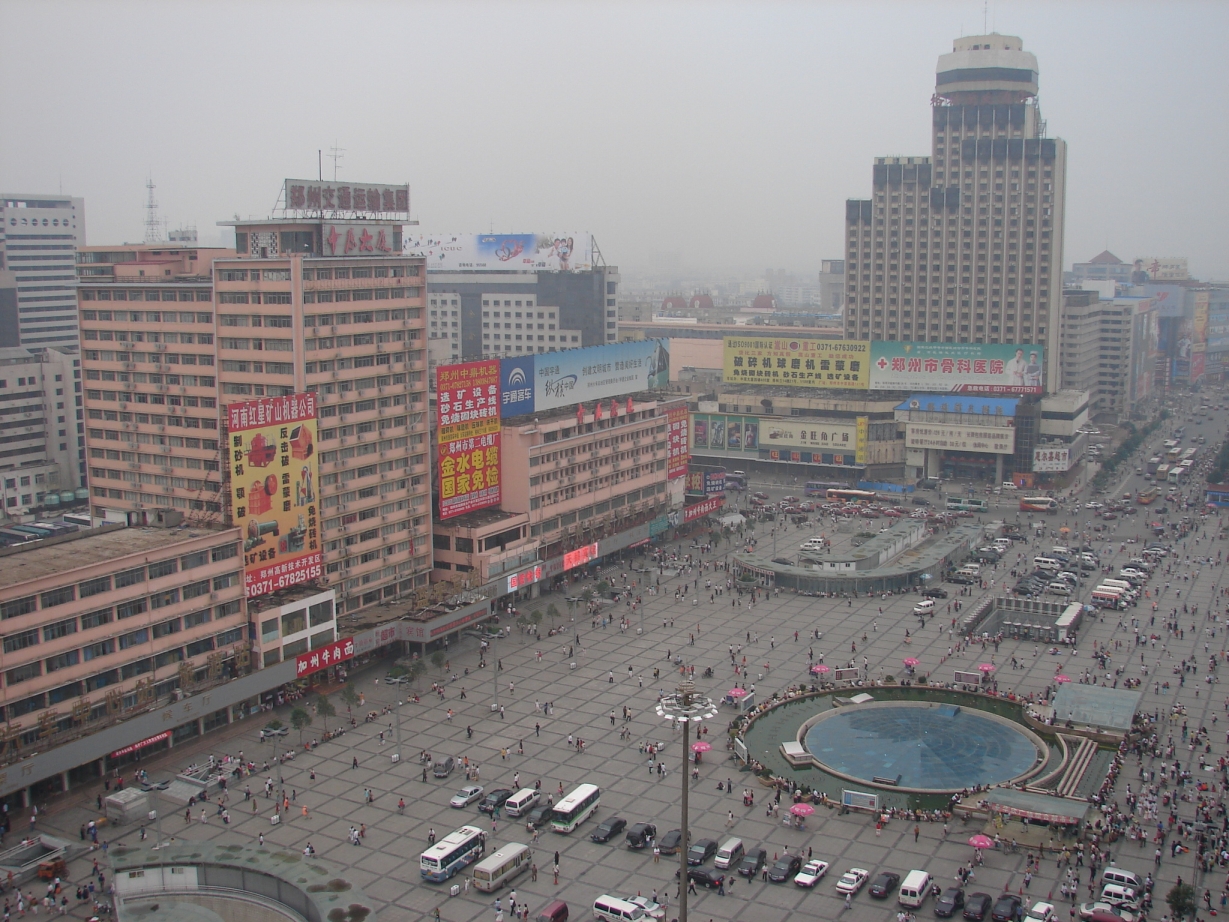As I gingerly walked down the treacherous mountain path in the pitch dark, my head throbbing from a deep gash and my legs cramping from six hours of hiking, I wondered where it all went wrong.
What started out as a routine trip to famed Shaolin Temple turned into a nightmare that almost stranded me and two friends overnight on a frigid Chinese mountain with no food or water. The harrowing adventure featured a trek to a magnificent monastery on the edge of a cliff, a collision with a giant cypress tree, a confrontation with a screaming cable-car operator and a $75 van ride home.
It all began Sunday morning, when Amber (our office’s administrative assistant), Patrick (a Chinese-American teacher and kung fu expert) and I took a 90-minute bus ride from Zhengzhou to Dengfeng. (One of the passengers was holding a pet quail that he rescued.) From there, we got a cab to nearby Shaolin Temple, the ancestral home of Chinese martial arts and one of the region’s major tourist sites.
After visiting the Buddhist shrine, part of a large complex of drab buildings that are mostly modern reconstructions, we watched a kitschy kung fu demonstration and walked past numerous stalls selling trinkets such as monk figurines and toy swords.
Anxious to see something more authentic, we decided to check out the newly built Sanhuangzhai Monastery near the top of 5,000-foot Shaoshi Mountain. (Unable to find a bathroom, I was forced to take an outdoor leak next to the Pagoda Forest, a monk cemetery filled with big brick pagodas. I hope I didn’t disturb any ghosts.)
The Sanhuangzhai Monastery is the home and brainchild of Shi Dejian, a Buddhist monk and kung fu master. It once was the site of a small temple where two old nuns lived. Master Dejian stayed at the the mountaintop retreat and thought it would be a perfect setting for a larger temple where he and his followers could meditate and practice their unique brand of kung fu. (I’ve seen video of Dejian practicing his moves on a sloped roof perched on a precipice, one mile above the valley.)
With the nuns’ permission, he embarked on the ambitious rebuilding project. Construction began in 2011 and was completed earlier this year.
To get there, we took a short cable-car ride up to a steep path primarily made of narrow stone steps. Most of the trail is protected by guardrails designed to prevent tourists from stumbling and falling off the cliff. I didn’t see any dead bodies below, so I assume they’re pretty effective.
The 5-mile climb takes from two to three hours, depending on your speed and stamina. We did it in 2½ hours, crossing a blue suspension bridge and winding our way across a huge chasm before finally reaching the monastery late in the afternoon on a cold, cloudy day. There were only two other tourists there when we arrived, a young Chinese couple that was busy taking pictures of the breathtaking scenery.
While the white stone buildings are closed to the public, Patrick made a cosmic connection by performing some kung fu moves on the monastery’s balcony. We also saw a few workmen putting the finishing touches on the complex, including a man etching Chinese characters into a stone wall with an electric carving tool.
It was getting late, so we started heading down the mountain. After hiking for an hour or so with no one else in sight, darkness fell and we were soon navigating the hazardous steps with just the patchy light from our cell phones. We met a Chinese man along the way who told us that the cable car had closed an hour ago, which meant we were facing another five hours of grueling hiking to get back to Shaolin Temple. (When we bought our cable-car tickets, none of us had the foresight to ask about the operating hours or to think about when the sun set. We’d never make it on Everest.)
Though we were exhausted and starving – all we had for lunch was soup and bread — we kept going, hoping against hope that the guy was wrong and the cable car was still running. On one of the rare flat sections of the path, with no light to guide me, I walked straight into a cypress tree. The impact knocked me to the ground and opened a blood-gushing cut on my forehead. I quickly got up, but I felt so woozy that Amber had to guide me the rest of the way while I pressed a paper tissue against my wound in a futile attempt to stop the bleeding.
When we reached the cable-car station, it was closed. We saw a light, however, so we hopped a fence to see if there was anyone inside. Sure enough, we heard some noise coming from a room. We knocked on the door, and it was answered by one of the two cable-car operators living at the station.
We explained our dire situation, but he wasn’t in the mood to help. Speaking to Amber in Chinese, he kept yelling that we should have left earlier and that our predicament was our own fault. Gee, thanks for the advice. Amber then called the police emergency number, but the person who answered seemed baffled and offered no assistance.
At this point, I was resigned to sleeping on the mountain. I climbed into one of cable cars, shut the door and started to nod off. About 20 minutes later, Amber woke me up and told me she had some new information: The cable-car guy said that if we walked down a different route for 40 minutes or so, a van would pick us up and take us back to Shaolin Temple. Lacking a better choice, we followed his directions and ended up in an isolated area where we spotted a dimly lit shack. We knocked on the door and it was opened by an elderly woman who showed us where the van was waiting, about 100 yards away.
Since the last bus from Dengfeng to Zhengzhou had already left, we had only two options: Go to the nearest hotel and stay overnight, or hire the driver to take us all the way back to our campus. We decided to go home, but the driver wasn’t sure how to get to Zhengzhou, so he picked up a friend who knew the way and together all five of us rode to Henan University of Technology.
We arrived on campus at 11 p.m., tired, hungry and sore. Amber immediately went to her dorm while Patrick and I grabbed a quick bite to eat. Then we returned to our apartments and collapsed.
I’m dizzy and nauseous as I write this on Monday night, which means I probably have a concussion. If I’m lucky, maybe that tree also knocked some sense into me.





you clearly were being repaid for pissing on the dead monks
Glad you had friends with you
Good grief, Jersey!
most wonderful
to live
to tell the tale
Generally Chinese hardware(s) infrastructures are well developed (Eg: Rail roads, Shaolin cable car systems etc). However it is apparent that Chinese heart-ware(s) service attitudes are not quite there yet. (Eg: that couldn’t be bothered cable car operator). Remember to care of the wound with twice daily antiseptic washes and appropriate dressings. Stay blessed!
So sorry to hear of your trouble on the mountain! Glad you are ok. Keep those moubtains for skiing!
Why doesn’t this story suprise me?????
Cheers! That was useful 🙂